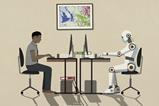How to make the most of this approach when teaching chemistry

What is blended learning?
It’s where students learn through a mix of face-to-face teaching and structured independent study using electronic or online media. Some definitions stipulate the face-to-face element as in the same room, while for some, it can mean a videoconference call.
Why the interest in it now?
Post-pandemic, it’s how most universities plan to get students back to learning in the autumn term. Schools have used blended learning as they moved from lockdown back to classroom teaching. With social distancing measures, schools have had to cut class sizes and time in the classroom. The big advantage of blended learning is that teachers can still deliver a complete curriculum but without full-time classroom attendance. Online teaching methods can be allocated flexibly, whether that’s a 50/50 split, or a 10% allocation.
What’s involved?
Planning, planning and more planning. How to cover all the work but split between two styles of teaching? And how to keep students engaged?
A good starting point is to consider a typical classroom setting. Under ‘normal’ circumstances, you will have planned certain activities when not working directly with students, like learning stations, for example. In blended learning, these ‘stations’ could take place remotely, either online or through practical activities.
There may be certain aspects of a topic that work best with face-to-face teaching. Practical work is the obvious one. So think about how to build around face-to-face contact with remote activities and resources. Beforehand, this could be presentations explaining the concept behind a new experiment, and afterwards watching online videos of this experiment to consolidate what they’ve learnt. Taking a flipped learning approach can help; for example, students can use homework time to do preparatory work.
For the online element, live interactions (through apps such as Google Classroom or Zoom) can be combined with pre-recorded lessons, presentations, lesson notes, diagrams or links to useful websites. Consider also setting tasks away from a device, such as project work, practical opportunities and discussions.
What are the challenges?
There’s a lot more to think about when lesson planning. With students at school for only part of the week perhaps, you will see only a proportion of the class face-to-face at any one time. You’ll need to work out what can be achieved in limited classroom time and combine this with topics that can be learned remotely.
Science teachers face a particular challenge as even if they prioritise practical lessons for classroom time, with social distancing in place, this might not be enough to cover everything. But there are many online resources for teaching practical science remotely (see below) which should help plug the gap.
With students not in the classroom all the time, it’s important to stay in touch. Students may struggle to do what they’re asked and you may not know when students are working, so provide opportunities for contact, such as inviting them to ‘like’ comments you post on Microsoft Teams. Build in assessment and feedback, both face-to-face and online. You also need to keep parents up to date. A checklist can help students keep track of their progress through a week’s worth of tasks, as well as providing teachers and parents with an easy way to monitor workload.
Workload is a particular challenge for students and teachers. Agreeing and sticking to reasonable targets for engagement levels can help ensure no one is overloaded.
Then there’s the challenge of using technology. Sometimes it won’t work, and sometimes students won’t be able to access devices or wifi. Hopefully your school knows who has access and who doesn’t. Where pupils don’t have easy access to online technologies, you’ll need to prepare homework packs of resources or provide textbooks.
It’s wise to pick an online program, platform or app (or two) and stick with them. Trying to use too many can eat up time, especially when you factor in the time needed to learn to use each one, for staff and students.
Will students benefit?
Yes. Blended learning has big attractions for students. With mobile devices and cloud-based services, students can ‘carry their classroom’ with them, giving them more flexibility and control over how, when and where they work. Some students engage more with learning as they respond to a wider variety of experiences and more autonomy. What’s more, the digital skills and communication methods they will develop will stand them in good stead for work in the future.
Is there a cost?
Devices and wifi cost money, but schools may have budgets to provide devices, particularly for disadvantaged students, or may ask parents to supply these. Creating homework packs and buying additional textbooks can also have cost implications.
With thanks to Katherine Haxton for her help in preparing this guide.
Where to go next
Views on blended learning
- The Scottish government’s Education Recovery Group’s guidance on blended learning
- Technology provider Stone Group’s thought piece about the role of blended learning
- An American view on all things blended learning
Resources for remote teaching
- Tips on how to teach practical chemistry remotely
- Advice on taking a week-by-week approach to setting work for home learning
- Teachers share their tips on using technology in teaching
- The Independent Learning Project for Advanced Chemistry, first published in 1983, consists of guides intended to allow students to study A-level chemistry with less teacher contact time than usual and with limited access to laboratories. Curriculums have changed but the approach remains useful.
- The Association for Science Education’s coronavirus hub offers resources for primary and secondary teachers.
- Oak National Academy is a DfE-funded initiative providing sequenced video lessons and resources. It helps schools plan for both learning in the classroom and at home. Its free, year-long plan of video lessons and resources covers a range of subjects in every year group.
- Seneca Learning offers free courses for students based on exam board specifications to help with homework and revision.














No comments yet